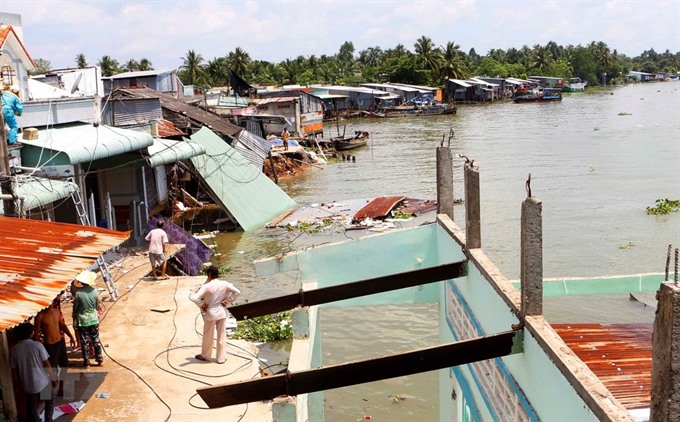 Environment
Environment

The amount of silt and sediment flowing down the Cửu Long (Mekong) Delta has been decreasing, while the erosion of riverbanks and coastlines around the area is becoming more serious.
 |
| A severe landslide submerged five houses and threatened dozens of other houses along the Ô Môn River in Cần Thơ City’s Ô Môn District on May 21. - VNA/VNS Photo Thanh Liêm |
CẦN THƠ — The amount of silt and sediment flowing down the Cửu Long (Mekong) Delta has been decreasing, while the erosion of riverbanks and coastlines around the area is becoming more serious.
Deputy Minister of Agriculture and Rural Development Hoàng Văn Thắng made the above announcement at a conference on finding technical solutions for riverbank and coastal erosion in the Mekong Delta held on Thursday in Cần Thơ Province.
The delta has 562 eroded sites along rivers and coasts spanning a total length of 786km.
From 2010 until now, the number of landslides has increased, affecting local lives and the economy, said Tăng Quốc Chính, director of the Disaster Control Department.
The area covered by mangrove forests has also declined.
The landslides occurring along riverbanks and coasts in the delta were mostly caused by human activities upstream, including the construction and operation of hydropower plants, according to Chính.
In addition, overexploitation of groundwater has also exacerbated the situation.
Rampant sand mining along the rivers has led to a shortage of sediment.
The total volume of mining is estimated at 15 million cu.m a year, not including the dredging of waterways.
Along with the extreme impacts of climate change and population growth, the number of ships and infrastructure development on rivers, canals and coastal areas have also caused further erosion.
A survey conducted by the Southern Irrigation Science Institute found sediment arriving down the Mekong Delta (from HCM City to Sóc Trăng Province) fell sharply due to a large decline in silt, leading to protection forests in front of coastal dykes being narrowed. — VNS




